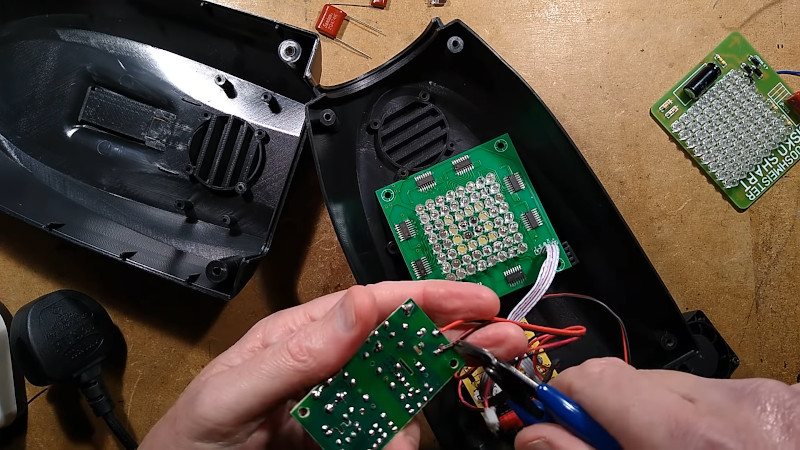Back in the early days of disco, filament bulbs were all the rage. Whether tungsten, halogen, or other obscure types, party lighting involved lots of watts and lots of heat. These days, the efficiency of LEDs makes everything a lot cheaper, lighter, and lower power. [Big Clive] decided to dive into a cheap moonflower-type disco light from China, replacing the insides along the way.

The light originally consisted of an 8×8 grid of LEDs, driven by shift registers for a simple chase effect. Surprisingly, the power supply and other hardware inside seemed to at least make an attempt to meet UK regulations. However, [Big Clive] had other plans, whipping up a replacement PCB packing 64 UV LEDs. The video is informative, showing how with a few simple passive components, it’s easy to drive these LEDs from mains without excessive circuitry required to step down to more usual DC voltages.
The final result is a neat UV grid light that would look excellent through some fog on the dance floor. We’ve seen [Big Clive]’s teardowns before, too – like this nefarious CAN bus interceptor found in a Mercedes. Video after the break.















Was hoping it was going to flash but this is still a cool, easy guide for running LEDs off mains
He has done at least a couple of other vids on that light IIRC. I’m sure it wouldn’t be too hard to find on his channel.
That “excessive circuitry” clamps spikes as well as 50/60 Hz voltages, that cap passes spikes on to the rest of the load.
You’ve missed the joke there…
When he says “excessive circuitry”, its a reference to the many imported products that dispense with it.
I figured that “excessive circuitry” meant the proper AC/DC step down converter board that he removed from the case, rather than the capacitive dropper the BigClive used.
Of course, the capacitive dropper circuit is much simpler, but only works for low currents and has poor regulation.
Nice. I would have liked to have seen how the original light worked before he tore it apart for the upgrade.
The LED’s are not UV, but purple.
No UV at all, according to my spectrometer.
More of a LED black light.
As Clive has repeatedly make clear in this video and many others exposing this crap as fake.
Um, how can you tell that about Clive’s LEDs? Did you do something spectacularly silly like trying to use your spectrometer on your monitor playing the video?
Rossmann makes that joke almost every time he uses the UV laser to cure conformal coating: ‘everyone look away from your screen, this is bad’
I wonder how “No UV at all” / “more of a LED black light” works.
It’s a good joke.
and I suppose also a contagious running gag AKA a meme :)
There are many different LEDs, including plenty in the violet-UVA range, that look just like that. Without actually measuring the spectrum of that exact type, you have no idea whether these are really UV or not.
Even when it was real, the lens would attenuate the UV portion of the spectrum.
Whilst he has videos pointing out many fake “germicidal” devices that use LED’s are clearly not UVC, technically, the 395nm LEDs, “purple” are in the UV spectrum as it ends at 400nm. So, yes, UV(A). Not UVC. Also, how did you get hold of his LED’s to measure with your spectrometer?
I love how Clive keeps alive the fun part of electronics. it reminds me the simple projects froms old magazines and such.
Also, thanks to him i learn that you can use 10ohm resistors to start fires!
Damn, which video is that…
He’s an entertaining guy with a great fascination for mostly all things.
I was pleasantly surprised to see the cheap (20$) chinese disinfectant usb salt thing working, same tech in hospitals used for surface cleaning.
Big Clive is a great tech and a very funny fellow if in doubt go hunt down his Fanny flambeaux video
Haha, I watched that again just a few days ago. Internet gold.
This is an excellent one as well: https://www.youtube.com/watch?v=9Ry4QBQejFU
And then this: https://www.youtube.com/watch?v=_v_9Rp86m80